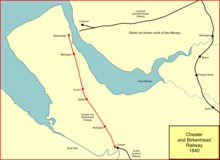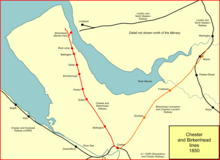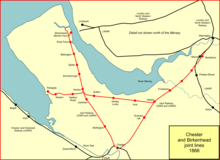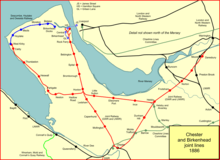Birkenhead, Lancashire and Cheshire Junction Railway
The Chester and Birkenhead Railway opened in 1840 with the intention of linking into the developing railway network; this proved more contentious than had been thought at first. The Birkenhead, Lancashire and Cheshire Junction Railway was built to connect Chester and the manufacturing districts of Lancashire by making a junction near Warrington with the Grand Junction Railway; it opened in 1850. The BL&CJR took over the Chester and Birkenhead Railway in 1847, keeping its own name for the combined company.
It was surrounded by the London and North Western Railway, which used aggressive underhand tactics to coerce it, but in 1860 the BL&CJR was taken over by the LNWR and the Great Western Railway jointly. The GWR benefited considerably from access to Manchester and Liverpool, The BL&CJR network became known as the Birkenhead Joint Line. For a few months in 1859 prior to the takeover it had used the name Birkenhead Railway.
Birkenhead developed considerably as a port, and the railway network there was improved accordingly. A direct line between Hooton and Helsby shortened the distance towards Warrington, but a branch line eventually reaching West Kirby in 1886 failed to develop as hoped.
The Great Western Railway ran express trains from London to Birkenhead, as well as heavy mineral traffic to and from South Wales; the LNWR was dominant in Liverpool and made less use of Birkenhead as a trunk route destination.
The West Kirby branch line closed in 1962 but the rest of the BL&CJR network is still in main line use.
Origins
The directors of the Grand Junction Railway had originally intended to reach Birkenhead, as a means of connecting to the docks on the River Mersey that was cheaper than getting directly to Liverpool, which would have involved an expensive crossing of the Mersey. The schemes to do so were turned down by Parliament, and the Grand Junction settled for connecting to the Liverpool and Manchester Railway at Earlestown instead. That was achieved in 1837.
In 1836 two schemes for a railway from Chester to Birkenhead gained support, and they went to the 1837 session of Parliament. The Chester and Birkenhead Railway would run from a junction with the Crewe line (as yet unbuilt) at Chester and would serve the several ferry terminals in Birkenhead, and it survived the Parliamentary process.[1]
Chester and Birkenhead Railway

The Chester and Birkenhead Railway was authorised on 12 July 1837, with capital of £250,000. It was to be a single line; no intermediate stations had been planned at this stage. George Stephenson was the engineer.[1][2][3]
Ferry and railway connections
The directors of the line were heavily involved with ferries at Birkenhead, and much energy was expended now in trying to get control of existing ferry companies, and securing the best railway access to the ferry terminals. The Grange Lane terminus at Birkenhead had to be equidistant from the three ferry piers.
The Chester and Birkenhead Railway had assumed friendly relations with the Chester and Crewe Railway, and it depended on the C&CR for access to the railway network. During the construction phase of the C&CR it simply ran out of money, and on 1 July 1840 it was taken over by the Grand Junction Railway. The GJR had always been hostile to the Chester and Birkenhead Railway, so this was a serious setback; a number of collaborative schemes at Chester between the two companies were now unlikely to be possible. Each company would have its own station at Chester, although there would be a connecting line by-passing both.[4]
The line was built as a single line with structures made suitable for later doubling of the line. The track gauge was to be 4ft 9in, in common with the Crewe line. By the end of 1843 Stephenson' estimate of £250,000 was obviously going to be inadequate: the new estimate was now £512,973.
A directors' inspection train ran over the line on 10 September 1840 and the official opening took place on 22 September 1840. In the morning a staff and contractors' train made the round trip from Birkenhead to Chester; there were no passing places and no electric telegraph, so the official party of honoured guests had to wait at Birkenhead with no knowledge of whether the other train was returning on time. The ordinary public service started the next day, 23 September, with five passenger trains each way daily, three on Sundays. From 15 December some passing loops had been installed, and the train service frequency could be improved, to two-hourly.[5]
The Chester to Crewe line of the Grand Junction Railway was opened on 1 October 1840. The GJR was in close partnership with the Liverpool and Manchester Railway, and were discouraged from collaborating with the Chester and Birkenhead, which the L&MR regarded as a competitor. Accordingly the GJR train times at Chester were contrived to avoid any convenient change of trains to the C&BR, and this went as far as the Irish mails having to be carried across the street in Chester from one station to the other, even though there was a through track.
In the first year the company did not do well financially; this was partly due to very large interest payments on loans and ferry terminal rental, and disappointing income. The share price fell, and the company had to engage in some financial manipulation to generate necessary cash.[5]
The original Birkenhead terminus of the line was a station at Grange Lane. In October 1843 a contract was let to make a line in tunnel, diverging from just south of the terminus to the Monks Ferry, It opened to passenger trains on 23 October 1844, and the Grange Lane terminus closed to passengers the same day, being developed later as a mineral depot.[5][2]
Amalgamation with the C&HR rejected
It was obvious that large scale railways were going to be successful, and a merger with the Chester and Holyhead Railway was proposed. The share transfer would have valued the Chester and Birkenhead Company at £496,762. This was less than the line had cost to construct, and other events drew the disparity to the attention of shareholders, so that the deal was suddenly rejected on 30 March 1845. and several board members resigned.[5]
Docks extension line
Extensive enlargement of the docks at Birkenhead was now being planned, and as there was crossover in directorships between the railway and maritime interests, the Chester and Birkenhead Railway proposed an extension, which became known as the Docks Extension Line, to a locality known as Bridge End. The necessary Act for the work received the Royal Assent on 21 July 1845. The line was about a mile long, and was disproportionately expensive as it ran in newly developed residential areas required extensive bridging and retaining wall construction.
The docks extension opened on 5 April 1847. Because of the considerable extra traffic expected, double track was laid on the main line, and was completed in the same year.[6][2]
Birkenhead, Lancashire and Cheshire Junction Railway

Interests in the Birkenhead docks were aware that they needed a railway connection to wards Manchester and the Lancashire manufacturing districts, to enable them to compete with Liverpool. The Birkenhead, Lancashire and Cheshire Junction Railway was incorporated on 26 June 1846 with capital of £1.5 million, to build from Chester to Walton Junction, near Warrington, where it would connect with the Grand Junction line, leading to Manchester. The London and North Western Railway was formed by merging the GJR, the Liverpool and Manchester Railway, and others, on 16 July 1846. This left the BL&CJR out on its own, and its attempts to negotiate for access at Warrington and beyond were frustrated for some time.[7][8]
In late 1846 negotiations for a merger of the Chester and Birkenhead Railway and the Birkenhead, Lancashire and Cheshire Junction Railway were finalising. A Parliamentary Bill authorising the merger was submitted, and it was passed on 22 July 1847, but provisions for leasing by other companies, chiefly the LNWR, were removed because of concerns about interests other than development of the docks. Nevertheless the BL&CJR now controlled the Birkenhead line.[7][2]
Construction of the Warrington line proceeded, although the shortage of money following the Railway Mania period slowed progress considerably. In October 1850 there was a formal opening, but the actual public opening took place on 18 December 1850.[7]
The BL&CJR decided to double the Chester to Birkenhead line, and align it so as to accommodate the Great Western Railway broad gauge, although the broad gauge was never laid.
A joint station was opened at Chester on 1 August 1848; it cost £55,000 and was to be accessible to the LNWR, Chester and Holyhead Railway, Shrewsbury and Chester Railway, and Birkenhead, Lancashire and Cheshire Junction Railway, and jointly operated.[9][10]
The Shrewsbury and Chester line had emerged from the North Wales Mineral Railway, and brought considerable volumes of minerals, chiefly coal, to Birkenhead; there was a triangle of lines at Chester station, enabling these trains to avoid the station. The LNWR felt threatened by this traffic, which it considered should come to it. Moreover the Shrewsbury and Chester Railway was aligning itself with the Great Western Railway as a possible through route to London. The LNWR started upon hostile acts towards the Birkenhead line and the Shrewsbury and Chester line, and these escalated in aggression and illegality.
The BL&CJR directors were supine in the face of these acts until a Shareholders' Meeting o n23 October 1850, when shareholder dissatisfaction motivated the Board to take a firmer line with the LNWR. The Shrewsbury and Chester (Birkenhead Station) Act of 1851 gave the Shrewsbury and Chester Railway running powers to Birkenhead greatly increasing the traffic.[9][11][12]
Sutton Tunnel collision
On 30 April 1851 a serious collision took place in Sutton Tunnel on the Warrington line near Frodsham. Huge numbers of passengers had travelled to Chester races, and were returning in a series of special trains. The BL&CJR directors had not made safe arrangements for the exceptional traffic. One train stalled on the approach to Sutton Tunnel; a second caught up with it and pushed it forward into the tunnel, at a very slow speed. A loosely managed time-interval system was in operation, and this permitted a third train to enter the tunnel at full speed. The tunnel was full of smoke from the struggling trains, and the resulting collision was at full speed. Nine persons died. The directors were heavily criticised for their lax management of the line.[13][14]
Involvement of the Great Western Railway
The Shrewsbury and Chester Railway found itself increasingly aligned to the Great Western Railway, and it began to be obvious that a through route from London to Chester over that railway and its allies was being formed In 1851 negotiations for a lease of the BL&CJR to the GWR were started,[12] but the idea fell through. Soon the rival LNWR attempted a lease of the BL&CJR, but the Birkenhead Town and Dock Commissioners successfully objected, because of the LNWR commitment to Liverpool.
In January 1854 there was renewed hostility against the Shrewsbury and Chester, and the matter went to arbitration; the arbitrator found in favour of the S&CR and awarded them running powers which gave them access to Manchester and Liverpool, as well as other important benefits.
From 1 September 1854 the GWR and the Shrewsbury and Chester Railway amalgamated, and the GWR was given running powers to Birkenhead, and was able to take advantage of the Manchester and Liverpool powers..[15][16]
The hostility between the companies waned a little and in 1858 the BL&CJR suggested joint ownership by the LNWR and GWR of their company. By Act of 1 August 1859 the BL&CJR company changed its name to the Birkenhead Railway, and the transfer of ownership took effect on 1 January 1860.[note 1][17][2][18][19]
Helsby branch
As much of the goods and mineral traffic to and from Birkenhead had Manchester as its terminal, the Joint companies decided to build the Helsby branch, a straight route of nearly 9 miles. It intersected the Shropshire Union Canal at Ellesmere Port, then a very busy dock, but no railway connection was made there. The branch opened on 1 July 1863, shortening the transit to Manchester by 11 miles.[20][2]
Parkgate branch

A branch from Hooton to Parkgate was planned, chiefly to access collieries at Neston, and potentially to develop a residential district. It opened on 1 October 1866 as a single line, with provision for later doubling and extension beyond Parkgate.[21][22]
Frodsham curve
The LNWR opened the direct line over the Mersey at Runcorn on 1 February 1868. In 1873 this was followed by their opening of the curve between Frodsham Junction and Helsby Junction. This considerably shortened the transit between Chester and Liverpool and abstracted nearly all of the passenger traffic that had gone via Birkenhead.[23]
Extension to Woodside station
Ferry arrangements which had seemed satisfactory in the earlier years were now seen to be commercially adverse, and the diversion of Chester to Liverpool passengers via Runcorn unsettled the Birkenhead commissioners. Following their pressure, an extension of the line to a new Woodside station in Birkenhead with direct access to the Woodside ferry was opened on 31 March 1878. The half mile line was known as the Birkenhead New Line; it was mostly in tunnel and deep cutting. The Monks Ferry branch (and the ferry itself) were closed on the next day, but the branch was later reopened to serve private sidings on it.[24][2]
West Kirby branch

In 1881 the Joint Line directors decided to make a railway from Parkgate to West Kirby, along a developing residential strip. This was authorised by an Act of 12 July 1882. It was hoped to agree a joint station with the Seacombe, Hoylake and Deeside Railway,[note 2] proprietors of the existing West Kirby station, fed from the Birkenhead end via Hoylake, but this proved impossible and a separate station was built. The line opened on 19 April 1886, and the passenger train service ran from Birkenhead Woodside to West Kirby via Hooton. In fact the two stations at West Kirby were combined in 1896.[25][26]
Mersey Railway
On 20 January 1886 the Mersey Railway opened between Liverpool and Green Lane Junction, Birkenhead, where it entered on the Joint Line. The Mersey Railway was steam operated through steeply graded tunnels. The section of the Joint Line at Green Lane Junction was already very congested, and it was agreed to make an interchange station at Rock Ferry, a mile or so south of the junction, with the Mersey Railway providing its own separate tracks to get there. The Mersey Railway extension to Rock Ferry opened on 15 June 1891.[27][28]
For a short time there was a through service from Liverpool Central to Paddington, via the Mersey Railway, starting in 1898.[28]
Quadrupling
The Birkenhead main line was seriously congested and it was decided to quadruple the tracks from Ledsham Junction to Birkenhead. This was completed in the period 1902 to 1908.[27][29]
From 1923
In 1923 most of the railway companies of Great Britain were formed into one or other of four large new companies, in a process called the "grouping", following the Railways Act 1921. The Great Western Railway was largely unchanged in the area under consideration; the LNWR joined the Midland Railway and others to form the new London Midland and Scottish Railway, the LMS. The Joint Line continued to be joint, between the GWR and the LMS.[18]
Road competition, especially for local passenger journeys, increased in intensity at this period, chiefly because of the roundabout nature of railway journeys from branch line settlements and the inconvenient location of many stations.
During World War II Liverpool suffered from heavy enemy bombing, but although the railway suffered damage, there was no strategic disruption. Birkenhead docks was heavily used for military purposes. A connection was laid in at Mickle Trafford between the Joint Line and the Cheshire Lines Committee route there, so as to divert goods traffic via Bidston, avoiding Chester LNWR.[30]
From 1948
At the beginning of 1948 British Railways was established as a state-owned organisation. Little initiative was taken to rationalise the formerly competing facilities, such as the wasteful multiple goods depots. Much continued as before, but the transfer of bulk goods to containers, and the increasing use of road transport abstracted from the railway, which declined, as did passenger business.
The Hooton to West Kirby line had never realised its potential, and it was closed to passengers on 17 September 1956, and completely in May 1962.[26]
The ordinary through trains from Birkenhead to London ceased on 5 March 1967, and on 4 November 1967 Birkenhead Woodside station was closed, the line being cut back to Rock Ferry for change to the Mersey Railway route.[31]
Electrification
From 1972 there were plans to extend the Merseyrail system, which was electrified in the central area, to the Chester line. Provision of funding and decision making took several years, but on 30 September 1985 electric operation took place from Rock Ferry to Hooton.
This was extended to run between the Liverpool Loop and Chester on 4 October 1993. The branch from Hooton to Ellesmere Port was electrified from 29 May 1994. There is (2019) an infrequent diesel service from Ellesmere Port to Warrington.[32]
Station list
Main line
- Birkenhead Woodside; opened 31 March 1878; closed 5 November 1967;
- Birkenhead; original terminus at Grange Lane; opened 23 September 1840; closed 23 October 1844;
- Monks Ferry; on spur off original line; opened 23 October 1844; closed 31 March 1878;
- Birkenhead Town; opened 1 January 1889; closed 7 May 1945;
- Lime Kiln Lane; opened 30 May 1846; renamed Tranmere 1853; closed October 1857;
- Rock Ferry; opened 1 November 1862; still open; convergence of line from Mersey Tunnel;
- Rock Lane; opened 30 May 1846; closed 1 November 1862;
- Bebington; opened 23 September 1840; still open;
- Port Sunlight; opened 1 May 1914 for workmen; opened to public 9 May 1927; still open;
- Spital; opened June 1846; still open;
- Bromborough Rake; opened 30 September 1985; still open;
- Bromborough; opened June 1846; still open;
- Eastham Rake; opened 3 April 1995; still open;
- Hooton; opened October or November 1840; still open;
- Sutton; opened 23 September 1840; renamed Ledsham 1863; closed 20 July 1959;
- Capenhurst; opened 1 August 1879; still open;
- Mollington; opened late 1840; closed 7 March 1960;
- Upton-by-Chester; opened 17 July 1939; closed 9 January 1984;
- Bache; opened 9 January 1984; still open;
- Chester; original terminus of Chester and Birkenhead Railway; opened 23 September 1840; closed 1 August 1848;
- Chester; joint station; opened 1 August 1848; still open;
- Mickle Trafford; opened 2 December 1889; closed 2 April 1951;
- Dunham; opened 18 December 1850; renamed Dunham Hill 1861; closed 7 April 1951;
- Helsby; opened September 1852; still open;
- Frodsham; opened 18 December 1850; still open;
- Frodsham Junction; divergence of line to Liverpool;
- Runcorn; opened August 1851; renamed Runcorn Road 1861; renamed Halton 1869; closed 7 July 1952;
- Runcorn East; opened 3 October 1983; still open;
- Norton; opened March 1852; closed 1 September 1952;
- Moore; opened 18 September 1850; renamed Daresbury 1861; closed 7 July 1952;
- Acton Grange Junction; divergence to lines towards Earlestown;
- Walton Junction; convergence with lines from Crewe towards Earlestown.
Ellesmere Port line
- Hooton; above;
- Sutton; opened 1 July 1863; renamed Little Sutton 1886; still open;
- Overpool; opened 15 August 1988; still open;
- Whitby Locks; opened 1 July 1863; renamed Ellesmere Port 1870; still open;
- Stanlow & Thornton; opened 23 December 1940 for refinery workers; opened to public 24 February 1941; still open;
- Ince; opened 1 July 1863; renamed Ince and Elton 1884; still open;
- West Cheshire Junction; divergence of line to Mouldsworth;
- Helsby; above.
West Kirby branch
- Hooton; above;
- Hadlow Road; opened 1 October 1886; closed 17 September 1956;
- Neston; opened 1 October 1866; renamed Neston South 1952; closed 17 September 1956;
- Parkgate; opened 1 October 1866; closed 17 September 1956;
- Heswall; opened 19 April 1886; closed 17 September 1956;
- Thurstaston; opened 19 April 1886; closed 1 February 1954;
- Caldy; opened 1 May 1909; closed 1 February 1954;
- Kirby Park; opened 1 October 1894; closed 5 July 1954; schools use continued until 17 September 1956;
- West Kirby; opened 19 April 12886; closed 17 September 1956; use transferred to Hoylake line station.
Notes
- As a working arrangement; it was ratified by Parliament and formalised effective from 20 November 1860.
- At this stage the Seacombe, Hoylake and Deeside Railway was isolated in the North Wirral; much of its business was passenger travel from Liverpool arriving at Seacombe by ferry. Opening of the Mersey Railway and subsequent developments connected the little company's line to the network in 1888.
References
- T B Maund, The Birkenhead Railway (LMS and GW Joint), Railway Correspondence and Travel Society, Sawtry, 2000, ISBN 090 1115 878
- Geoffrey O Holt, revised Gordon Biddle, A Regional History of the Railway of Great Britain: volume 10: the North West, David & Charles Publishers, Newton Abbott, 1986, SBN 0 946537 34 8, pages 44 to 50
- Donald J Grant, Directory of the Railway Companies of Great Britain, Matador Publishers, Kibworth Beauchamp, 2017, ISBN 978 1785893 537, page 110
- Maund, pages 7 to 9
- Maund, pages 9 to 12
- Maund, pages 16 and 17
- Maund, pages 18 to 20
- Grant, pages 43 and 44
- Maund, pages 21 to 23
- E T MacDermot, History of the Great Western Railway: volume I: 1833 – 1863, published by the Great Western Railway, London, 1927, page 346
- MacDermot, pages 356 to 359
- MacDermot, pages 370 to 372
- Maund, page 22
- Captain Laffan, Report to the Commissioners of Railways into the Fatal Collision in the Sutton Tunnel on 30th April 1851, published by the House of Commons, 29 May 1851, accessible at https://www.railwaysarchive.co.uk/docsummary.php?docID=1815
- Maund, pages 22 to 27
- MacDermot, pages 382 to 390
- Maund, page 27
- Grant, page 44
- MacDermot, pages 4266 and 427
- Maund, pages 32 and 33
- Maund, pages 33 and 34
- Holt, page 52
- Maund, page 34
- Maund, pages 39 to 41
- Maund, pages 42 to 44
- Holt, page 53
- Maund, pages 44 and 45
- Holt, page 50
- Merseyside Railway History Group, Railway Stations of Wirral, published by Ian and Marilyn Boumphrey, Prenton, 1994, ISBN 1 899241 02 7, page 5
- Maund, pages 51 to 57
- Maund, pages 69 to 74
- Maund, pages 76 to 78